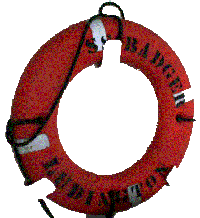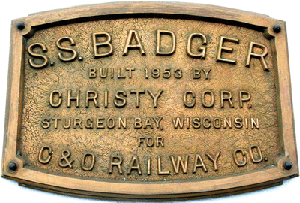| Back to Home | Back to Travel |
 |
The S.S. Badger |
 |
| LOA
410' 6" Displacement 8000 tons Passengers 620 |
Beam
59' 6" Cruising Speed 18 M.P.H. Automobiles 180 |
The Great Lakes
For those who are unfamiliar with them, the
The huge metropolis
of
It is roughly 60 - 80 miles, across Lake Michigan, depending upon the place of crossing. From the middle of the lake, it is impossible to see across to either shore. Sailors go across, regularly, and there are several races every year; but even so, this lake is no joke, and even large ships have been taken by it. Lake Michigan has a maximum depth of 980 feet. Storms can come up suddenly, and waves on the lake, when driven by appropriate winds, can be surprisingly large.
The western side of the lake is the erosional side, and thus features impressive cliffs, and rocky shores. The eastern side is the depositional side, and features huge dunes, piled up along the shore. Both shores have numerous coves, and anchorages, though the Michigan side is far richer in natural harbors. The western side is far more developed and populous, even without the Chicago -Gary metropolis on it's lower portion. The eastern side has a wild, touristy feel to it.
Historically, the area has been populated by native tribes for thousands of years. Europeans first came to the area in the mid sixteen hundreds. Settlement did not really begin until over a hundred years latter. During the interim, the area was home to trappers, explorers, and hunters, as well as to it's older inhabitants --- the woodlands Indian tribes. The Indian tribes remain, as do the settlers; but the hunters, trappers, and explorers have long disappeared, though some of their legacy remains.
The Ships
The S.S. Badger was built in 1953 as a ferry for rail cars. The C&O Railroad, for whom the Badger was built, had no routes of it's own, going through Chicago. Because of this C&O trains needed to lease time on the tracks of other railroads, which cost them money, and also time, since they would have lower priority than the trains of the companies that actually owned the tracks. The four hour trip of the Badger, and of the Badger's two sister ships was far shorter than the trip around Chicago, particularly considering time spent on sidings, waiting for use of the tracks.
In the tradition of the classic ocean liner, the Badger is a true steamship. The C&O was a large carrier of coal, so it was decided to make the Badger a coal burner. The current owners are no doubt pleased with this, since it makes the badger relatively immune to today's fluctuating oil prices, uncertain supply, and fickle market. Coal is plentiful, here in the U.S, and inexpensive. Great mountains of it are heaped up around the Badger's berths, on both sides of the lake. The coal is burned in a set of four Foster Wheeler type boilers, which feed high pressure steam to a pair of Skinner Uniflow, four cylinder steam engines. The engines turn at a stately 100 R.P.M., and generate 3500 H.P. each.
Though built over 50 years ago, the Badger may very well outlive many of the newer diesel, and oil burning ships. This is because of it's fuel. Coal is cheap, abundant, and widely available. We have huge reserves of it in this country, so there is no need to import it, from halfway around the world. It is also quite safe, and can easily be stored and stockpiled. A tank full of oil is a bomb waiting to go off; coal is not so temperamental.
Taking the Trip
The S.S. Badger makes two trips a day, during the height of the summer, reducing this to a single daily trip in each direction, during the spring and fall. As of this writing, passage costs $59 one way, or $99 round trip. There are also numerous specials, and discounts available. The passage takes four hours, and crosses a single time zone. There are television lounges, a movie theater, and several places to eat, onboard. There are also a number of staterooms, for those who wish to nap their way across the lake. Many passengers like to stroll the decks, while others bring books, or work on their laptop computers.
My first view of the Badger was at night. There is a crossing just
after midnight, during the summer season, and the place was surprisingly busy.
Though we had no intention of taking a night crossing, we did want
to get a look at the ship, and the middle of the night seemed like
as good a time as any. The place was
packed, in large part, because The Badger offers a 20% discount, for
passengers and vehicles going across at night. Outside of the summer
season, the Badger only makes one crossing, in each direction, per
day.
Though the days of the train ferry across the lake are long gone, The Badger still does it's share of commercial traffic. Trucks wait to get on, and their drivers are happy for the chance to get a 20% night crossing discount, and perhaps a chance to sleep in a stateroom, for a few hours during the passage.
This is also a good way to avoid the time, trouble, tolls, and irritations of driving through Chicago. In particular, you get to avoid Gary, and southern Chicago, which are some of the most frightening, and unpleasant places in the country. Gary, along with St. Louis (currently number 1), Washington DC, Detroit, Baltimore, and Oakland, pass around the title of America's Most Violent City, like a sort of an unwanted football. Gary is presently number ten, after having had been number one for so long; but those who know the place have confidence that it will soon rise in the standings.
On the
night before we were to leave, my brother and I went down to the
docks, to purchase tickets, and see the ship. We also went to make
certain that we would be able to find the place, the next day. It
was dark, rainy, and a bit chilly, as we parked, and
approached the ship. It was also crowded and noisy, in the dock
area. People were lined up inside, to get tickets, and were lining
up their cars and trucks in the parking area, in preparation for
boarding. It was, frankly, quite a bit of fun, and we found
ourselves almost wishing that we had booked night passage. Still,
you don't see much out on the lake at night, everything, undoubtedly
settles down once the ship sails, and the idea of arriving in
Michigan at 5:00 in the morning held little appeal for us.
Tickets, for the two of us, and my van, came out to $180, which I paid by credit card We then went back to our hotel room, and ended up staying up the entire night, barely waking up in time to have some lunch, and get to the docks in time to leave. Passengers with vehicles are requested to arrive an hour before embarkation, to ease organization, and placement of vehicles on the ship. Weight is a consideration, and the ships company attempts to balance the cars out evenly, among the sections of the ship. Once a vehicle is checked in, a yellow tag is hung from the mirror, and it is parked according to the order that it should be loaded onto the ship. Though I was one of the first to arrive, my van was loaded almost dead last, due to it's weight, and size. vehicles are driven aboard, and parked, by ships staff, and no access is permitted to the car deck, once the ship has sailed.
Though
not exactly a cruise at sea, The Badger has the feel, as well as the
look, of a big ocean going ship. The 18 knot passage is so
smooth, that you can scarcely feel yourself moving. Down
below, there is plenty to do, while out on the decks it is windy,
and even in the summer, a bit chilly.
The badger caters primarily to tourists these days. It is a comfortable, and entertaining environment in which to cross the lake. A number of the original staterooms were removed, to make room for some extra amenities, like a theater, museum, and ships store. Still, 40 remain, and can be booked for $42, one way, or $74 round trip. For those taking an early passage, there is a breakfast buffet. The ship also offers a chance to sleep aboard, during the fall, on the Michigan side. The whole place was decorated like a pirate ship, during our passage, which should give a hint as to the general feel and atmosphere on board.
The Badger is fun. The people who own, and run this ship, do it because they like ships, and enjoy running the service. There are, doubtless, places in which they could have gotten a higher return on investment; but they wanted to run a car ferry service across one of the Great Lakes. I won' t repeat the history here, as it can be found at the SS Badger website. The people involved with this ship are obviously proud, and enthusiastic about what they do, and a bit of this rubs off on the passengers. In Manitowoc, and especially in Ludington, the coming and going of the Badger are a big deal. The locals come out and wave, as the ship comes in, and will sometimes line the breakwalls, and docks. It seems that the enthusiasm has rubbed off on them too.
| Back to Travel | Forward to Cruising on the Badger Photos >>> |